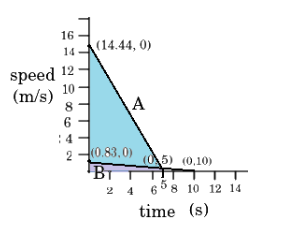Answer
331.3k+ views
Hint- To solve this question, we use the basic theory related to the topic speed, distance and time. In this question, for the first car: Initial velocity Final velocity, Time taken, for second car: Initial velocity, Final velocity, Time taken, the distance travelled by a moving body is given by the area under its speed-time graph.
To convert km/hr. to m/s we need to multiply by $\dfrac{{\text{5}}}{{{\text{18}}}}$.
Complete step-by-step answer:
Now, As given in question-
Initial speed of the car A: u=52 km/hr.
= 52${\times }\dfrac{{\text{5}}}{{{\text{18}}}}$= 14.44 m/s
The car stops in 5 seconds i.e v=0 at t=5
Initial speed of the car B: u=3km/hr.
= 3${\times }\dfrac{{\text{5}}}{{{\text{18}}}}$= 0.83 m/s
With the help of these initial and final points for both the cases, we can plot the graph of speed vs time.
Area under the speed-time graph gives the distance covered.
∴ Distance covered by car A (\[{{\text{x}}_{\text{A}}}\]) = $\dfrac{1}{2} \times 14.44 \times 5$= 36.1 m
∴ Distance covered by car A (\[{{\text{x}}_{\text{B}}}\]) = $\dfrac{1}{2} \times 0.83 \times 10$=4.15 m
Thus, car A travels more distance than B.

Note- In this question, the data given in the problem are in different units. So, we should first convert the km unit into m units. And with the help of these initial and final points for both the cases, we can plot the graph of speed vs time.
To convert km/hr. to m/s we need to multiply by $\dfrac{{\text{5}}}{{{\text{18}}}}$.
Complete step-by-step answer:
Now, As given in question-
Initial speed of the car A: u=52 km/hr.
= 52${\times }\dfrac{{\text{5}}}{{{\text{18}}}}$= 14.44 m/s
The car stops in 5 seconds i.e v=0 at t=5
Initial speed of the car B: u=3km/hr.
= 3${\times }\dfrac{{\text{5}}}{{{\text{18}}}}$= 0.83 m/s
With the help of these initial and final points for both the cases, we can plot the graph of speed vs time.
Area under the speed-time graph gives the distance covered.
∴ Distance covered by car A (\[{{\text{x}}_{\text{A}}}\]) = $\dfrac{1}{2} \times 14.44 \times 5$= 36.1 m
∴ Distance covered by car A (\[{{\text{x}}_{\text{B}}}\]) = $\dfrac{1}{2} \times 0.83 \times 10$=4.15 m
Thus, car A travels more distance than B.

Note- In this question, the data given in the problem are in different units. So, we should first convert the km unit into m units. And with the help of these initial and final points for both the cases, we can plot the graph of speed vs time.
Recently Updated Pages
Basicity of sulphurous acid and sulphuric acid are

Assertion The resistivity of a semiconductor increases class 13 physics CBSE

Three beakers labelled as A B and C each containing 25 mL of water were taken A small amount of NaOH anhydrous CuSO4 and NaCl were added to the beakers A B and C respectively It was observed that there was an increase in the temperature of the solutions contained in beakers A and B whereas in case of beaker C the temperature of the solution falls Which one of the following statements isarecorrect i In beakers A and B exothermic process has occurred ii In beakers A and B endothermic process has occurred iii In beaker C exothermic process has occurred iv In beaker C endothermic process has occurred

The branch of science which deals with nature and natural class 10 physics CBSE

What is the stopping potential when the metal with class 12 physics JEE_Main

The momentum of a photon is 2 times 10 16gm cmsec Its class 12 physics JEE_Main

Trending doubts
Difference between Prokaryotic cell and Eukaryotic class 11 biology CBSE

Fill the blanks with the suitable prepositions 1 The class 9 english CBSE

How fast is 60 miles per hour in kilometres per ho class 10 maths CBSE

What organs are located on the left side of your body class 11 biology CBSE

a Tabulate the differences in the characteristics of class 12 chemistry CBSE

How do you solve x2 11x + 28 0 using the quadratic class 10 maths CBSE

Change the following sentences into negative and interrogative class 10 english CBSE

Which are the major cities located on the river Ga class 10 social science CBSE

What is BLO What is the full form of BLO class 8 social science CBSE



